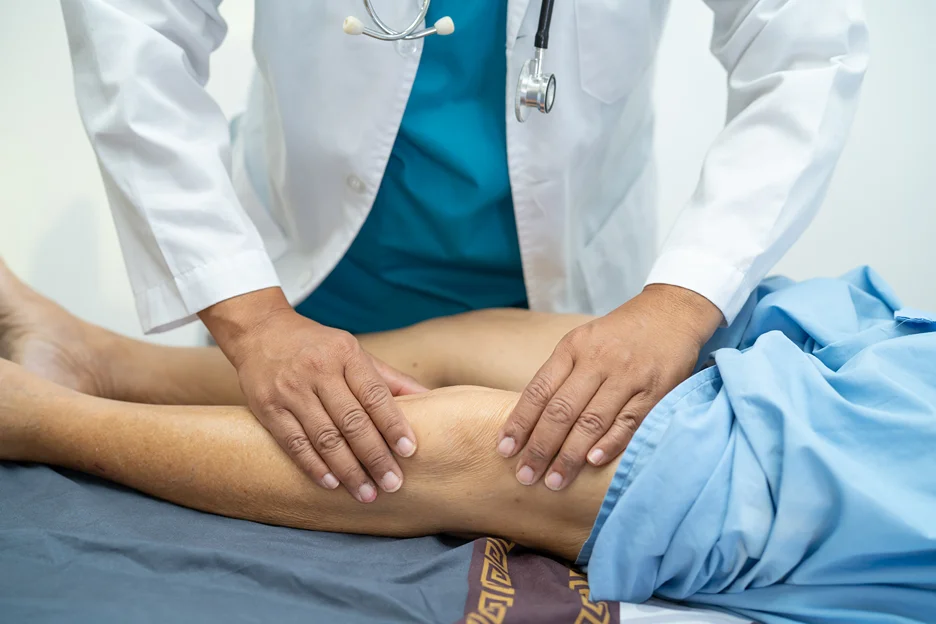If you’ve ever felt a sharp, shooting pain radiating from your lower back down through your hips and legs, you may be familiar with sciatica. This agonizing condition can make daily activities difficult and disrupt your quality of life.
One of the most painful and debilitating symptoms associated with sciatica is muscle spasms. These involuntary contractions of the muscles can cause severe pain, stiffness, and limited mobility.
What are Sciatica Muscle Spasms?
While the hallmark symptom is nerve pain radiating down the leg, sciatica can also trigger various secondary effects like muscle spasms. These involuntary and sudden contractions of the muscle occur when the nerves controlling the muscle become irritated.
Sciatic nerve irritation can cause the muscles it innervates to cramp or spasm painfully. These spasms typically occur in the buttocks, legs, or feet. The affected muscles may feel stiff and tender to the touch during an episode.
How Do You Treat Sciatica Muscle Spasms?
Managing painful sciatica muscle spasms involves a multifaceted approach, including self-care, physical therapy, medication, and alternative treatments. The right combination of remedies will depend on the severity of your symptoms.
Here are some of the most effective options:
| Technique | Description |
| Self-Care | – Applying hot or cold packs to the affected muscles can help reduce spasms and pain. Try alternating hot and cold therapy for best results. – Gentle stretching and exercises like knee-to-chest pulls and piriformis stretches can alleviate muscle tension. – Good posture is critical to take pressure off the sciatic nerve and reduce spasms. – Relaxation techniques like meditation help relax the muscles. |
| Physical Therapy | – Targeted exercises to strengthen the back, hips, and legs. – Assistance improving flexibility and range of motion. – Postural correction and joint mobilization. – Pain-relieving modalities like ultrasound or electrical stimulation. |
| Medication | – Over-the-counter NSAIDs to reduce inflammation and pain. – Muscle relaxants to relieve painful cramping and spasms. – Prescription pain medications or steroid injections for severe symptoms. |
Can Muscle Spasms Cause Sciatica?
Muscle spasms themselves can actually trigger the onset of sciatica symptoms. The involuntary, forceful muscle contractions of a spasm can put pressure directly on the sciatic nerve. This pinches the nerve and causes the radiating leg pain associated with sciatica.
Muscle knots and trigger points in muscles like the piriformis can irritate the sciatic nerve and cause symptoms. Muscle imbalances and weakness in the hips or core can pull on the pelvis and spine, compressing the sciatic nerve.
Are Leg Cramps Associated with Sciatica?
Painful leg cramps and charley horses are common symptoms associated with sciatica. The leg cramps occur due to the sciatic nerve irritation and can be worsened by certain activities or movements.
A Cross Sectional Study revealed that leg cramps was the most common symptom for sciatica with 94.3% recorded for women and 90.3% in men. Some key points about leg cramps related to sciatica are:
- They often strike at night during sleep.
- Certain motions like coughing or sitting can trigger them.
- The calves or feet are usually affected rather than thighs.
- Stretching and massage can help provide relief.
How are Sciatica and Muscle Spasms Related?
Sciatica and muscle spasms share a cyclical, interconnected relationship. Sciatica can cause secondary muscle spasms due to nerve irritation. Conversely, muscle spasms can themselves trigger sciatica by compressing the nerve.
Underlying sources of nerve compression like herniated discs, piriformis syndrome, or spinal misalignment can lead to both muscle spasms and sciatica pain. Chronic muscle tension or imbalance in the hips and back can lead to sciatica and spasms. Sciatic exercises help strengthen these areas.
Can Sciatica Lead to Spasms in the Body?
Sciatica can definitely cause spasms throughout the lower body due to the effects of nerve compression on the muscles. The radiating pain can often lead to spasms in the legs, feet, buttocks and hamstrings as the nerve branches extend through these areas.
Sudden cramping or charley horses in the calf can indicate sciatica. Muscles may involuntarily twitch or tighten due to inflammation around the compressed nerve. Spinal misalignment, disc herniation, or scar tissue can pinch the nerves leading to widespread spasms.
Is it Normal for Sciatica Patients to Have Muscle Cramps?
It is very common for those suffering from sciatica to experience associated muscle cramps and spasms. Sciatica patients may deal with cramping at some point, either in the early stages or as their condition progresses.
The muscle cramps occur as a result of the nerve irritation and inflammation. Some key points:
- Cramps often affect the calves and feet as the sciatic nerves branch into these areas.
- Certain motions like bending or sitting can trigger the cramps.
- Nighttime leg cramps are particularly common with sciatica.
- Muscle relaxants, gentle stretching, and massages help relieve the cramping.
How to Alleviate Sciatica Muscle Cramps

Living with recurring muscle cramps can feel debilitating and make daily activities difficult. Fortunately, there are many remedies that can provide relief from the painful cramping caused by sciatica. Here are some effective options:
- Apply ice packs or heat therapy like heating pads to relax the muscles.
- Gentle stretching and light exercises for the affected muscles.
- Over-the-counter medications like NSAIDs to reduce inflammation.
- Massage therapy and trigger point therapy to release muscle knots.
- Chiropractic adjustments and physical therapy to address spinal and muscular sources of pain.
How to Rehabilitate Sciatica Muscle Spasms Through Physical Therapy
Physical therapy is a critical component of effective treatment for sciatica and the resulting muscle spasms. Under a physical therapist’s supervision, customized exercise routines can help reduce nerve compression, strengthen the back and core, improve flexibility, and ultimately alleviate spasms and cramping.
Some of the techniques physical therapists utilize include:
- Controlled stretches and core stability exercises to stabilize the spine in proper alignment and take pressure off the sciatic nerves.
- Muscle energy techniques to relax tight, cramped muscles.
- Joint mobilization of the hips, knees or ankles to improve mobility if stiffness is contributing to spasms.
- Soft tissue massage and trigger point therapy to relieve muscle knots.
- Gentle aerobic activity like walking, swimming, or cycling to reduce inflammation.
- Modalities like ultrasound, TENS units, and traction to reduce pain.
What Exercises Can Help Improve Sciatica Muscle Spasms?
While rest and medication can provide temporary relief, exercise is vital for long-term improvement of sciatica muscle spasms. The right sciatica exercises can strengthen and stretch the muscles to reduce cramping episodes.
Some of the most effective workout motions to reduce spasms include:
- Glute bridges to strengthen the buttocks and take pressure off the nerve.
- Gentle hamstring stretches to increase flexibility in the backs of the thighs.
- Calf raises and stretches to alleviate charley horses and cramps.
- Planks and abdominal exercises to improve core strength and spinal stability.
- Piriformis and hip flexor stretches to create space for the sciatic nerve.
- Low-impact cardio like walking or swimming to improve circulation and increase endorphins.
When is Surgery Necessary for Sciatica Muscle Spasms?
Most cases of sciatica and related muscle spasms can be managed without surgery through conservative treatment methods. However, surgery may be considered if the spasms and sciatica are severely debilitating and other therapies have failed.
Specific scenarios where surgery may be warranted for sciatica muscle spasms include:
- Progressive nerve damage or muscle wasting indicating cauda equina syndrome.
- Severe spinal fractures or instability contributing to ongoing nerve compression.
- Large herniated discs or spinal tumors directly impacting nerve roots.
- Chronic spasms causing significant mobility limitations.
How to Reduce the Risk of Sciatica Muscle Spasms
While there is no foolproof way to avoid sciatica completely, there are measures you can take to reduce your risk of developing painful muscle spasms:
| Tip | Purpose |
| Exercise regularly | Strengthen spinal muscles |
| Maintain proper posture | Reduce spinal nerve compression |
| Avoid prolonged sitting | Allow disc decompression |
| Manage your weight | Reduce spinal loading |
| Avoid repetitive motions | Prevent irritation of spinal nerves |
| Quit smoking | Protect spinal disc health |
| Use proper lifting techniques | Protect spine during lifting |
| Sleep on your side | Align spine and relieve nerve pressure |
How to Practice Yoga for Sciatica Muscle Spasm Relief
Gentle, restorative yoga poses can help lengthen tissues around the sciatic nerve and alleviate painful spasms. Here are some of the best sciatica yoga exercises:
- Supine pigeons pose to stretch the hips and release the piriformis.
- Cat-cow stretch to mobilize the spine with flexion and extension.
- Thread the needle twist to open up the lower back laterally.
- Child’s pose to gently decompress the spine and hips.
- Bridge pose to strengthen the glutes and hamstrings.
- Supported forward folds like wide-legged forward bend to relieve tension in the back of the legs.
How to Alleviate Muscle Spasms During Pregnancy
Sciatica and related spasms during pregnancy require a gentle, holistic approach. Here are tips for relieving symptoms while protecting mom and baby:
- Stretching routines that safely open the hips like figure-four pose
- Prenatal massage by therapists trained in pregnancy techniques
- Acupuncture in safe areas distal to the spine
- Supportive belts to take pressure off the pelvis
- Sitting with knees elevated to reduce lumbar compression
- Sleeping on the side with a pillow between the knees
- Low-impact exercise like walking and swimming
The OBGYNs and prenatal specialists at Kaly provide tailored guidance on soothing sciatic and muscle spasm pain throughout all trimesters. Let us help you find comfort during this special time.
Experience Relief from Muscle Spasms

At Kaly, we understand how much chronic sciatica and unrelenting muscle spasms can negatively impact your daily functioning and quality of life. Our team of specialists is committed to helping you finally achieve long-term relief through customized treatment plans.
To get started on the path towards relief from your sciatica muscle spasms, request an appointment online or get in touch with us today. Our patient care team is ready to help get you out of pain and back to doing what you love!
FAQs
Are Muscle Tremors Associated with Sciatica?
In rare, severe cases of sciatic nerve damage, patients may experience muscle tremors in the affected leg or foot. The tremors and uncontrollable shaking occur due to irritation of the nerve fibers controlling these muscles.
Some key points on tremors related to sciatica:
- They indicate disruption of the neurological signals to the muscles.
- Tremors usually only occur in extreme sciatica cases involving significant nerve compression.
- More common symptoms are weakness or numbness rather than tremors.
- Imaging tests like EMG may be needed to evaluate nerve function.
How Does Chiropractic Care Relieve Muscle Spasms?
Chiropractic care is often an integral part of treating sciatica and the associated muscle spasms. Chiropractors use a combination of spinal adjustments, soft tissue massage, and exercise recommendations. Chiropractors can help relieve muscle spasms by:
- Spinal manipulation to improve alignment and take pressure off compressed nerves.
- Massage therapy to relieve muscle knots and trigger points causing spasms.
- Passive stretching and exercises to strengthen core muscles for better spinal support.
- Low-force adjusting techniques and traction to relieve nerve root irritation.
- Ultrasound, electric muscle stimulation, and other modalities to relax the muscles.
How Does Acupuncture Alleviate Muscle Spasms?
Acupuncture is a safe, effective option for finding relief from sciatica muscle spasms. Fine needles are inserted into trigger points along the affected muscles and nerve pathways. This provides several benefits:
- Releases endorphins which act as natural painkillers.
- Increases blood flow to relax the muscles.
- Reduces inflammation around the compressed nerves.
- Relieves muscle knotting and spasm trigger points.
- Promotes overall relaxation of the nervous system.
